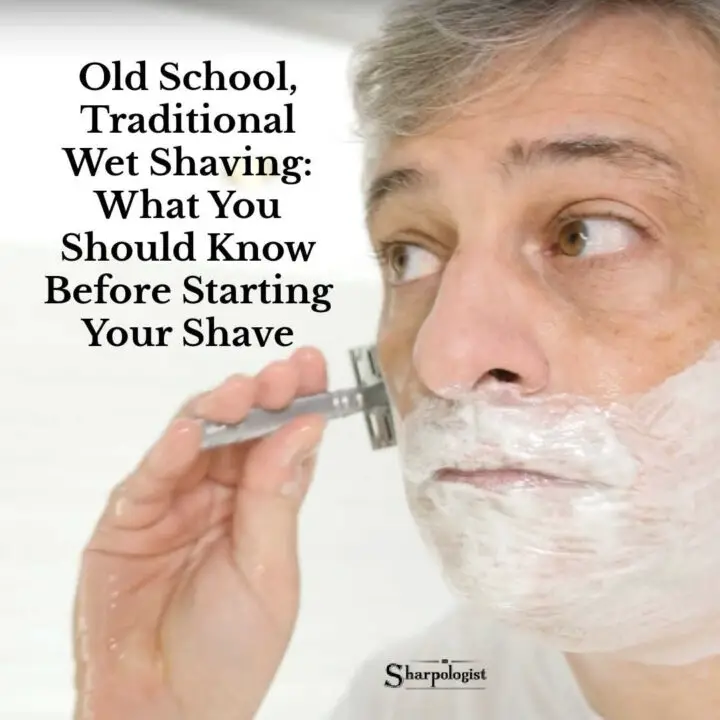
[Note from Mantic59: this is one of a series of articles updating some of my original content on Youtube from 15 years ago. Call it a “resharpening!” ]
Shaving is a ritual that many men go through every day. However, the main priority for most people when it comes to shaving is what kind of razor should they use. There are dozens upon dozens of options, from disposable razors to an electric shaver; and all sorts of creams, soaps, oils, gels, and foams. But which one will provide the best shave and least irritation? This article breaks down the basics then advocates going the old school shaver route with traditional wet shaving (sometimes called classic wet shaving) and a guide to the wet shave for beginners!
What is the difference between wet and dry shaving?
Wet Shave vs dry shave?As you might guess from the terminology, dry shaving is removing hair without water or lubricants. Wet shaving is removing hair with the aid of water and a stabilizing lubricant.
Typically, dry shaving is accomplished by running a device (usually powered by electricity) over clean, dry hair and skin. The actual cutting is done by rotating or oscillating blades that work just above the surface of the skin.
What is wet shaving? Wet shaving is typically accomplished by your hand moving a stable blade (or blades) across clean, wet hair and skin. The “wetness” of wet shaving is related to the combination of water and another product (shave cream, gel, soap, oil, etc.) to create a stable protecting and lubricating layer on the skin for the razor blade(s) to track on, as shaving with water by itself is usually too unstable to use for more than a brief time.
Admittedly, sometimes those definitions are not so “cut-and-dried” (if you’ll pardon the pun): for example, there are “wet/dry” razors that let you wet shave with electric razor products.. But the broad definitions in the previous paragraphs are good enough for this article.
Is It Better To Wet Shave Or To Dry Shave?
That answer depends on your ‘environment’ and your preferences. Dry shaving generally needs a reliable source of electricity (to either power the shaving device directly or to charge batteries). Wet shaving requires a reliable source of clean water.
Dry shaving is “safer” in that it’s almost impossible to cut yourself enough to draw blood: if you’re on blood-thinning medication or otherwise have bleeding issues, a wet shaving blade might cause some concern. On the other hand many people find dry shaving can more easily cause other types of irritation like redness from “razor burn.”
Dry shaving is usually faster than wet shaving.
Wet shaving can remove hair at (or even a bit below) the skin level, while dry shaving cannot.
What About Traditional Wet Shaving?
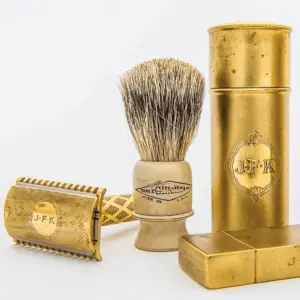
Modern wet shaving products are replete with “Improvements” and “conveniences” to make the shaving process better (?) for the average consumer. Multi-blade cartridges with “lift and cut” technology, lubrication strips, pivoting heads, and canned shaving gel are just a few of the things that have been introduced over the past 50 years or so.
However, many of these changes were done more for business reasons rather than for actually improving the shave experience. As profitable patents expired or consumer interest in a particular “shave system” waned, new shiny toys attempted to attract consumers into a “walled garden” of branded products that may have had few, or dubious, additional real benefits.
Some consumers started rebelling against this concept when a major manufacturer announced a five-blade-vibrating-handle wet shave razor around 2006. That it was not compatible with the previous generation of razor handles, and the prospect of spending US $4 for a replacement blade cartridge, was motivation for some to say enough! and to start looking for alternatives. This spurred the “modern” traditional shaving movement.
Traditional wet shaving involves shaving with products and techniques that have been around for 100 years (or more) but largely forgotten by the general public…or at least no longer regularly taught between parent and child. Usually this means shaving with a razor that has a single blade (commonly referred to as a wet shave safety razor even though the term is sometimes associated with modern cartridge razors as well), a shave brush, and a lathering shave soap or cream.
But where the process of shaving really counts most for a lot of people–the closeness and comfort of a shave–traditional shaving can easily trump other types of shaving.
Why You Should Improve Your Shave With Traditional Wet Shaving
First and foremost: shave performance. Many people who try classic shaving are surprised just how good the shave is. It’s a matter of “unlearning” some bad habits and using good products in the proper way instead of parroting television commercials without actually understanding the process of shaving.
Another advantage of traditional wet shaving can be cost-savings (as along as you don’t dive too far down “the rabbit hole.” More on that later): the primary “consumable” of shaving is the razor blade. While the typical multi-blade shave cartridge costs around US $3-4, the typical ‘classic’ safety razor blade costs a mere fraction of that (on the order of about US $0.25 in bulk).
Beyond that there are also some more amorphous advantages. Some link it to a cherished childhood memory of watching their father or grandfather in the bathroom shaving. And some connect it to a romanticized idea of a simpler time, like getting a shave and haircut and an old fashioned barber shop.
Others consider traditional shaving as a form of ritual or meditation.
And a few think it’s part of a bad-ass lifestyle.
Variations Of Traditional Wet Shaving
Most variations of traditional wet shaving revolve around the razor itself. The razor most people remember when they think of “vintage” consumer razors is the Gillette double edge safety razor first introduced in the early 1900’s and whose design peaked in the late 1950’s (though still produced in quantity well into the 1970’s).
What many people (especially in the U.S.) don’t know is that these types of razors are still available (a few sold by Gillette itself), even in “brick and mortar” stores.
But that is by no means the only option. The razor designs of several Gillette competitors over the years still endure: both vintage and new examples of “Injector” style and “GEM” style safety razors and blades can still be found.
A final razor example is the straight razor or “cut throat” razor of Sweeny Todd (Amazon affiliate link) fame. By no means nearly as “safe” as a safety razor, there are still devoted users of the manually stropped and honed blade edge. But straight razors are out of the scope of this article: I’ll stick to “safety” razors here.
All these types of razors are used with a shaving brush and a lathering shave cream or soap for the traditional wet shave experience.
Non-Traditional Traditional Wet Shaving??
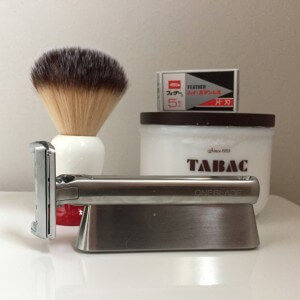
Over the past five-to-ten years there have been several products that have used traditional wet shaving concepts in innovative ways. So I guess it’s non-traditional, traditional shaving?
This hybrid approach can take several forms. There are several razors that use a single blade but on a pivoting head. And similarly, Gillette has their SkinGuard razor that uses two blades in a pivoting cartridge but that does not use the “lift and cut” technology that most multi-blade safety razors have and that can be a problem for those with .
And of course there are some shavers who are quite content to use a modern multi-blade cartridge razor.
But again, a shave brush and lathering shave cream or soap are used to complete the traditional experience.
The Tools Of The Traditional Wet Shave Trade
I have mentioned that a razor, brush, and lather are the main parts of the traditional shave. But let’s take a closer look at some of the “tools of the trade.”
Water
Whether you’re using cheap canned shaving foam (just don’t…) or the most expensive shaving cream, it’s really water that does the “heavy lifting” of a shave, preparing the skin and the hair. But water alone is too “volatile” to use by itself for most people (though admittedly some can shave in the shower with just water as long as there is a continuous flow available). Shaving products exist to stabilize and hold water against the skin–and yes, provide even more lubrication and cushion–with additional skin-friendly ingredients. More on this later.
Pre Shave Products Like Pre Shave Oil Or Gel
An often overlooked aspect of shaving is preparing for the shave. This can be as simple as washing the area to be shaved with generous amounts of water and a gentle soap made specifically for the face (even if the area to be shaved isn’t the face: using a “deodorant soap” or “body bar” can strip off too much of the skin’s natural oil that is need provide a comfortable shave).
But in addition there are other pre shave products specifically designed to provide more lubrication and/or cushion to a shave lather. Pre shave oil, cream, or gel can provide a kind of “security blanket” if the shaver feels their shaving cream or soap may be somewhat deficient.
Razors: Handle And Head
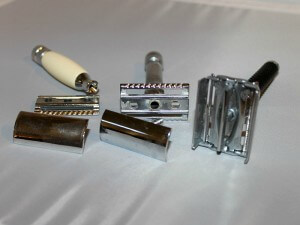
As mentioned earlier, when someone thinks ‘old school safety razor’ odds are they’re thinking about the classic “twist to open” (TTO) double edge (DE) safety razor cutting facial hair.
DE razors are typically constructed in one of three ways. A three piece design is the oldest (and easiest to manufacture) type, consisting of a handle, a base plate, and a top cap. The base plate and top cap together are generally referred to as the head. Two piece DE’s have the base plate permanently mounted to the handle. A one piece TTO DE razor is the most common, most popular razor type just before the ascent of modern cartridge razors: the Gillette SuperSpeed is the “classic” TTO.
Double edge razors have heads that can be divided into two general groups: Open Comb and Safety Bar. Open Comb’s have obvious “teeth” that help guide heavy stubble and shaving cream into channels. Safety Bars have a solid (or scalloped) bar that provides some additional protection to the skin from the blade’s edge. There are also a number of variations beyond these two broad categories though, such as adjustable razors, slant-bar razors, razors that use a double edge blade snapped in half, and some razors that are just kind of tough to classify.
For more information Click/Tap here to read The Double Edge Safety Razor Illustrated Guide And FAQ.
Beyond the DE are some other single-blade razors worth mentioning.
Single edge (“SE”) razors have historically taken a back seat to double edge razors. But despite the (relative) obscurity some have endured and a couple are even thriving.
The Schick (later PAL) “Injector” single edge razor was the perennial “number two” competitor to Gillette’s double edge razors, back in the day. Injector razors had a unique “hands off” blade loading mechanism, where the blades were loaded in a magazine and fed through the razor. And it had a devoted following, too, before Schick also switched to razor cartridges and joined the “blade wars” in the 1970’s. However there are now at least two sources for “Injector” style razors with some great design engineering to back them up.
Over the past few years there have been several razor artisans recreating designs of the vintage GEM razor from over 100 years ago.
Still others are creating razor designs of their own that take blades used in barber hair-shaping razors or that use blades that had been used in vintage razors no longer in production (one of the “non traditional, traditional” razors took the vintage razor blade design and created a whole new razor around it, the OneBlade razor).
Blades
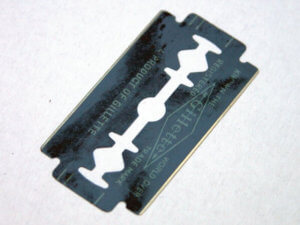
Once again, when someone thinks about “classic” razor blades their mind turns to the ubiquitous double edge razor blade. But as mentioned in the previous section there are a number of alternate designs.
The thing to remember is this: no matter the design, even if blades of different brands or manufacturing locations look the same, they can shave very differently! So if you are new to traditional wet shaving, try several different brands of blades until you find the one(s) you like best, then order in bulk for greatest savings.
For more information Click/Tap here to read The Science Of Blade Sharpness
Shaving Brushes
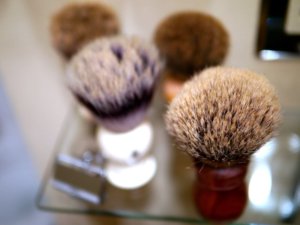
Using a shave brush is a way to prepare stubble for shaving by mixing lathering cream or soap with water to make an effective lubricant for a razor blade to track on.
There are a number of benefits to using a shave brush:
- Hydration: a shave brush mixes lathering cream or soap with water to make an effective lubricant. It also reduces the amount of air in the lather, preventing the skin from prematurely drying and possibly causing irritation.
- Cleaning And Exfoliation: using a shave brush produces a mild exfoliating effect on the skin.
- Lather Coverage: when shave products are applied with just fingers, hairs tend to matte to the skin, making them more difficult for the razor’s blade edge to get at. A shave brush lifts hair and surrounds it with lather, requiring less work from the razor.
- A Better Shave Experience: for some, that feeling of applying a warm, fragrant lather on the face is very relaxing and appealing.
Shaving brush hair knots are typically made out of badger hair, boar hair, horse hair, or synthetic material. Each type has their advantages and disadvantages–for example, has historically been the preferred material but the practices involved with “harvesting” badgers is controversial. material have improved significantly over the past few years.
For more information Click/Tap here to read The Shaving Brush Illustrated Guide And FAQ
Shaving Mugs, Scuttles, And Bowls
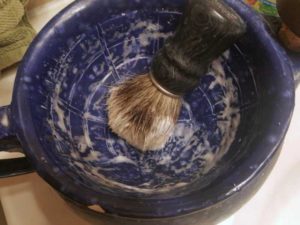
There is continued interest in shaving mugs, bowls, and scuttles. And with good reason: some are built so that lather stays warm during the shave, providing a more luxurious experience. Some are built to make lather more quickly. And others are meant to show off some aspect of the shave–or the shaver. There are quite a few styles, new and vintage.
But let’s try to distinguish between a scuttle, a bowl, and a mug. I think the main difference is that a scuttle is made to hold hot water in a separate compartment. The others use water from the sink or other vessel.
Vintage occupational shaving mugs are probably what most people think of when they see the term “shaving mug.” Here are the romanticized notions of the turn-of-the-(20th)-century barber shop, a place for men to meet and discuss all things while getting their shave and hair cut .
The lathering bowl is a somewhat recent development. Actually people have used bowls to lather for a long time, but these are purpose-built specifically to build shaving lather with a shaving brush. They’re usually distinguished by having a “rough” or textured inside-bottom to improve lather-making production. Some potters have integrated the textured bottom concept to a scuttle design.
For more information click/tap here to read Shaving Mugs, Bowls, And Scuttles – What They Are And How To Use Them
Lathering Shaving Creams & Soaps (Artisan And Commercial)
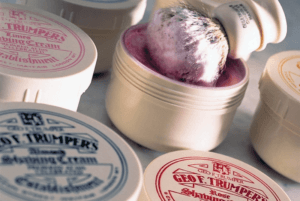
Not too many years ago there were a few high-quality, old-school, men’s shaving creams and wet shaving soaps from the established (mostly British), traditional, high-end brands (George Trumper, Taylor Of Old Bond Street, Truefitt And Hill, DR Harris, etc.) that were familiar to those who use a safety razor; and some low-end, every-man products like Williams Mug Soap, Burma-Shave Soap, and (a little later) Van Der Hagen.
Today there are many quality options for the traditional wet shaver at virtually every scent profile and price point. The wet shaving soap artisan space is particularly robust now, with many excellent options.
And some shave brush-friendly products, such as Gillette Planet Kind shave cream, are probably available at your local mega-mart or drug store.
Aftershave Products
Aftershaves are the products that are applied immediately after shaving to provide some combination of irritation relief, skin moisturizing, and protection from the elements. There is a surprising amount of choice in aftershave products, and many widely available aftershaves are actually pretty good (probably because many “mega-mart” razors and shaving creams are so bad).
Aftershaves can be divided into two broad categories: balms and splashes.
Shave Balm has a thicker consistency and typically have ingredients (like aloe vera) that provide more irritation and razor burn relief, and act as a moisturizer to the skin (particularly in cold or dry climates).
Aftershave Splash is more watery and generally contain a combination of ingredients to cleanse and provide some degree of antiseptic or antibacterial protection to the skin. They’re more popular with those with oily skin or in hot, humid climates and in some cases can be effective at combating razor bumps or ingrown hairs. Witch hazel is a popular classic shaving product among some enthusiasts.
Beyond these ‘general coverage’ products there are also more specialized aftershave products for spot treatment.
An alum block (Amazon affiliate link) is basically a big chunk of mineral which, when wetted and run over the skin after shaving, offers some relief from razor burn, and exhibits some astringent properties to close up tiny nicks (“weepers”).
A styptic pencil or equivalent (Amazon affiliate link) is designed for the more “acute” treatment of deeper shaving cuts.
Wet Shaving Products For Travel?
While you can take your shaving gear with you when you travel, there are specialized products. Razors that can break down into smaller pieces. Brushes that can be stored in a cylindrical handle. Creams and soaps that are “TSA friendly.”
Shaving while traveling is pretty much like shaving at home, with one very specific thing to keep in mind. Odds are you will be in very different environmental conditions and you will be much more active than usual. That means you and your skin will probably be dehydrated. So be sure to not only drink water throughout the day but also to keep your skin moisturized. You may even want to apply a little aftershave balm or moisturizer before going to bed for a little extra help. And don’t try to go for that “baby’s butt” close shave either. Go for looking presentable and if you are able to get a better shave than that, consider yourself lucky.
Do I Really Need All This Stuff? How Much Will Traditional Wet Shaving Cost Me?
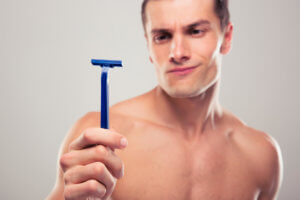
If you have kept up until now you may be a little overwhelmed. Do you really need all these products for traditional shaving? How much will all this stuff cost?
The short answer is no, you don’t need all “this stuff.” And the stuff you do need doesn’t have to cost a lot. There are options at almost every price point. You just need to make sure you are getting the right products for your needs, and you need to pay closer attention to design and (especially) build quality of products at the low end of the price range. But to give you an idea of the price ranges (in US Dollars):
Razor: the typical, popular double edge razors go for about US $15-$40. Click/tap here to read Sharpologist’s double edge razor recommendations.
Blade: when purchased in bulk figure a per-blade cost of a double edge blade at US $0.10-$0.50 (but probably closer to the lower end of that range).
Brush: a good shave brush used to be a “high dollar” item but decent, reliable examples are now in the range of US $20-$50 depending on size and fiber type. Click/tap here to read Sharpologist’s recommendations.
Cream/Soap: a high-quality lathering shave soap or cream will be in the range of US $15-$25 for an amount that will last you many months of regular use. And there are lower-cost options that may not provide a specific scent you are interested in but perform perfectly well for under US $10. Click/tap here to read Sharpologist’s shave cream recommendations and here to read Sharpologist’s shave soap recommendations.
Aftershave: there are excellent aftershave balms available for under US $15. Click here to read Sharpologist’s aftershave recommendations.
A Traditional Wet Shaving Starter Kit?
If you don’t feel like shopping for individual items from different sources, you can find a curated traditional wet shaving kit available from several wet shaving vendors. Click/tap here to read Wet Shaving Starter Kits.
Essential Traditional Wet Shaving Concepts
No matter what specific traditional wet shaving products you end up with, there are some common concepts that are important to know. Here is a guide to wet shaving concepts. Learn to wet shave this way and you will get consistently good results.
Water
As you may have guessed from previous sections, traditional wet shaving is all about the water. Water for cleansing, water for hydrating the skin and hair, water as a base for lather. Water is the key to a great wet shave.
Grain
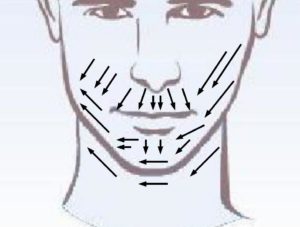
Knowing how the hair grows is essential to a comfortable shave because it allows you to remove more hair per stroke with less chance of irritation, providing more beard reduction (see below) more quickly.
Grain is also important to know so that if you decide to pull the skin taut to shave you can know which direction to pull. Over-stretching the skin makes the possibility of irritation or ingrown hairs much more likely.
Reduction By Passes
Related to grain is to shave in cycles or “passes,” with each pass progressively removing hair more closely to the skin. Even multi-blade razors with their “lift and cut” theory follow this technique, along with the “grain.”
(Lack Of) Pressure
Putting too much pressure on the razor creates a “valley” for the blade, not only reducing the efficiency of the blade but also making irritation more likely. Razors that that have a pivoting head can partly compensate for too much pressure but don’t rely on it. Hold the razor by the bottom of the handle, tilt your head to one side, and let the head of the razor rest on your cheek. Feel that? That’s the most amount of pressure you want to use.
Blade Angle
Since you may not be using a razor with a pivoted head, you will have to be concerned with the angle where the blade meets the skin. Blade cartridges set this angle for you, with some engineer (or marketer!) deciding what is best for everyone. If you are using a classic double-edge or single edge blade (including a straight razor) you must set this angle yourself.
Efficiency
Efficiency is not immediately repeating a shaving stroke. It is common for a shaver to unconsciously repeat strokes with the razor over the exact same spot twice…or three times…or more….
If you can pay closer attention to your shave stroke and avoid repeating them in the same pass you can not only save time but also avoid irritation. And if you do it correctly, with the classic three pass approach, your shave will be just as close.
Conclusion – Stay Tuned
These are the general concepts and products for a traditional wet shave. Next come the specifics of building a good lather and shaving so well your barber may envy you….

Interesting article. However, I have a hard time agreeing with the chart on blade sharpness. Ranking Derby and Astra as being sharper than Feather is contrary to my experience.
Well done, thank you
Comments are closed.